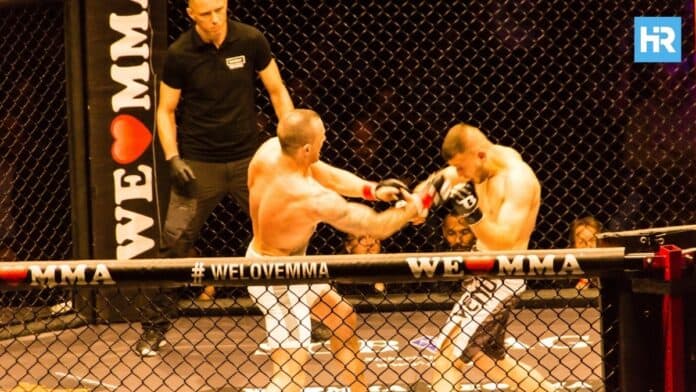Mixed Martial Arts (MMA) might seem like a modern sport, but its roots go back thousands of years to ancient Greece.
Pankration is one of ancient Greece’s oldest and most intense combat sports. Back in the day, this was for survival and showing off pure strength and skill.
The Greeks took it so seriously that they even included it in the ancient Greek Olympics, where it quickly became one of the most popular events.
This guide will explain Pankration’s history, rules, and lasting impact and show how it connects to MMA as we know it today.
- Pankration was an ancient Greek sport that mixed boxing and wrestling and is considered the precursor to modern MMA.
- Introduced in 648 BC, Pankration was the most brutal Olympic event, with minimal rules and high stakes.
- Alexander the Great helped spread Pankration’s influence across Asia, developing martial arts like kung fu and jiu-jitsu.
What is Pankration? The Origins of the Greek Sport
The name “Pankration” comes from two Greek words: “pan,” meaning “all,” and “kratos,” meaning “power.” This name fits the sport well because Pankration was about using all your strength and skills in a fight.
According to Greek myths, heroes like Hercules and Theseus created Pankration. While it’s hard to separate fact from fiction, we know that Pankration was introduced to the Olympic Games in 648 BC and likely been around for centuries before that.
Historically, pankration was a sport and a part of military training, especially for Spartan warriors and the Macedonian army under Alexander the Great.
The Greek martial art was designed to prepare warriors for the brutal realities of battle, where weapons could fail, and survival depended on one’s ability to fight with bare hands and feet. This made Pankration a practical and essential skill for survival in ancient Greece.
Nonetheless, the sport eventually died out after being banned in 393 AD by a Christian emperor who wanted to eradicate pagan practices.
But it was brought back to life in the 20th century by a Greek-American martial artist named Jim Arvanitis, who helped make it popular again and eventually influenced modern MMA.
Who Were the Pankratiasts?
Pankratiasts, the athletes who practiced Pankration, were more than just competitors; they were warriors.
Pankration was a part of a Greek soldier’s training, especially for the hoplites, heavy foot soldiers. The wrestling techniques in Pankration helped soldiers stay balanced and quickly get back on their feet during battles, which could be a matter of life or death.
Over time, some Pankratiasts became legendary figures. For example, Polydamas was an Olympic champion known for his incredible strength.
Legends say he once defeated three Persian warriors using only a stick. Whether entirely true or not, these stories show how Pankration athletes were admired for their strength and courage.
The Harsh Rules of Pankration
Pankration had two types: ano pankration, where fighters stayed on their feet, and kato pankration, where they could fight on the ground. The sport had only two main rules: no biting and no eye-gouging.
Besides that, almost anything was allowed, including strikes and submissions that could seriously injure or even kill an opponent.
Pankratiasts fought naked and covered in oil inside a wrestling pit. There were no rounds or time limits—the fight ended only when one competitor surrendered, was knocked out, or died.
Without modern safety measures, it was not uncommon for fighters to die from strangulation or other submission moves. Competitors could signal defeat by raising their arms or tapping out, much like today’s MMA.
Despite its brutality, Pankration was highly respected in ancient Greece. It was a test of endurance, skill, and mental toughness, with many fighters choosing death over the shame of surrender.
Pankration Fighting in the Olympic Games and Other Competitions
Pankration was a major event in the Pan-Hellenic games, including the Olympics. The Spartans, known for their military discipline, usually did not participate in Pankration or boxing but focused on wrestling.
Pankratiasts competed in single-elimination tournaments, representing their city-states. The tournaments could have at least four rounds, with the winner becoming a hero in their homeland.
Victors in Pankration tournaments were celebrated as heroes, receiving rewards and widespread recognition.
Their names were inscribed on the Olympic victor lists, and they were awarded various prizes, the most famous of which was the olive wreath.
These champions embodied the Greek ideals of physical and mental excellence, and their achievements were immortalized in history.
The Decline of Pankration
The natural end of Pankration came in 393 AD when the Roman Emperor Theodosius I banned all pagan festivals, including the Olympics, as part of a push to spread Christianity across the empire.
This ban led to the end of many traditional practices, including Pankration. Even though it was officially outlawed, there’s evidence that Pankration continued secretly in some places until the sixth century. But over time, it gradually disappeared from public life.
Even after Pankration stopped being practiced openly, its influence did the opposite of vanish. The techniques and ideas of Pankration spread around the ancient world, especially through Alexander the Great’s conquests, who recruited the best Pankratiasts into his army.
As Alexander’s empire stretched into Asia, it’s believed that elements of Pankration helped shape various Eastern martial arts, like kung fu and jiu-jitsu.
The Lasting Legacy of Pankration
Pankration’s legacy is evident in today’s mixed martial arts (MMA). The way Pankration combines striking and grappling is very similar to MMA. Since fighters are trained in multiple styles, they must be proficient in standing up and on the ground.
The idea of a no-holds-barred fight, central to Pankration, also appeared in the early days of MMA, when there were very few rules.
Pankration’s influence goes beyond just the fighting techniques; it’s also about the spirit of the sport. The focus on adaptability, handling tough situations, and staying strong in any fight still resonates with athletes today.
As the first known mixed martial art, Pankration set the stage for modern MMA’s diverse and exciting world, showing its strong and long-lasting legacy.






